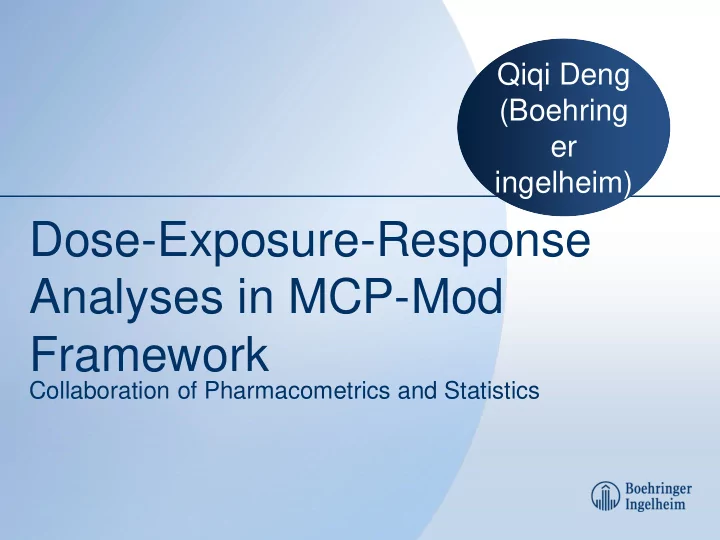

Qiqi Deng (Boehring er ingelheim) Dose-Exposure-Response Analyses in MCP-Mod Framework Collaboration of Pharmacometrics and Statistics
Acknowledge • This is a joint work with • Benjamin Weber (Director, Pharmacometrics, Boehringer Ingelheim) • Other team members includes • Dooti Roy (Biostatistics, Boehringer Ingelheim) • Sree Kurup (summer intern, Pharmacometrics, Boehringer Ingelheim) • Junxian Geng (summer intern, Biostatistics, Boehringer Ingelheim) PMx/Weber - Internal use only 2
Basic Principle of Clinical Pharmacology Orally Administered Systemically Acting Drugs Dose-Response Drug Dose or Drug concentration dosing concentration Effect at the site of regimen in plasma action Population Pharmacokinetics (POPPK) Exposure-Response PMx/Weber - Internal use only 3
Why exposure-response analysis may improve the modeling • Under assumption of “exposure drives response”, PK data can help separating PD (Pharmacodynamics) variability from PK (Pharmacokinetics). • Berges and Chen (2013) compared exposure-response approach and dose-response approach, and showed that – While the accuracy for ED50 estimation was comparably good with both approaches, the precision was up to 90 % higher with concentration-response approach – The difference was most notable when clearance was highly variable between subjects and the top dose was relatively low. – The higher precision by the concentration-response analysis may lead to up to 20 % higher success rate for selecting right dose for subsequent confirmatory trial. 07/06/2017 4
MCPMod – deal with model uncertainty Recommendations: At least 10 fold dose range, 4-7 doses, 3-5 dose 5 response shapes
Model selection/average in MCPMod on dose response • MCP step provided a way for models selection or model averaging. • Improve performance of prediction by avoid over-fitting. exponential 8 sigEmax 6 6 6 4 4 y 4 y y 2 2 2 0 0 0 0 50 100 150 200 0 50 100 150 200 0 50 100 150 200 x x x 07/06/2017 6
Case Study Phase II Dose Finding Trial • Six dosing groups – five active treatment groups and one placebo group • 10, 25, 50, 75, and 100 mg • Duration: 28 days • Number of subjects: 40 per dosing group • Biomarker defined on an 0-100 scale and measured at day 7, 14, 21, and 28 • Primary endpoint: Change from baseline in biomarker at day 28 • Plasma samples at days 14 and 28 (4 samples per day per subject) PMx/Weber - Internal use only 7
Pharmacokinetics (PK) C max, steady stat C max AUC 0-24,steady state C trough, steady state C trough PMx/Weber - Internal use only 8
Simulation parameters Dose – Exposure – Response Dose 𝜄𝑊𝑒 ∙ 𝜄𝑙𝑙 − 𝜄𝜄𝜄 𝑓 − 𝜄𝐷𝐷 𝜄𝑊𝑒 ∙ 𝑈𝑙𝑈 − 𝑓 − 𝜄𝑙𝑙 ∙𝑈𝑙𝑈 𝜄𝑙𝑙∙ 𝐺 ∙𝐸𝐸𝐸𝐸 Exposure: 𝐷𝑛𝑛𝑛 𝑈𝑈𝑈 = Simulation Value parameter Where 𝐵𝐵𝐷𝐵𝐵 𝑇𝑇 = 𝐸𝑙𝐸𝐸𝐸 𝑒𝐸𝐸𝐸 𝜄 𝐷𝐷 ∙ 𝐸 𝜃𝐷𝐷 𝜄 𝐹𝐹 0 𝜄 𝑓𝑓𝑓𝑓 ∙ ( 𝐵𝐵𝜄𝐵𝐵𝐵𝐵 ) 𝜄𝐼𝐼𝐼𝐼 𝜄 𝐸𝑓𝑙𝑓 100 Effect = 𝜄 𝐹𝐹 + 𝜄𝐼𝐼𝐼𝐼 + ( 𝐵𝐵𝜄𝐵𝐵𝐵𝐵 ) 𝜄𝐼𝐼𝐼𝐼 + 𝜏 𝜄 𝐹𝐵𝐵𝐷50 𝜄 𝐼𝐸𝐸𝐸 1.45 𝜄 𝐹𝐵𝐵𝜄5𝐹 5 𝜏 25 𝜄 CL (L/h) 25 𝜄 Vd (L) 45 𝜄 ka (1/h) 0.65 9
Exposure Response of primary endpoint at day 28 Exposure-response model could be fit via MCPMod approach to determine shape PMx/Weber - Internal use only 10
Fitted Shapes Exposure response modeling Dose response modeling using AUC24 11
D-R curve vs C-R curve exponential 8 sigEmax 6 6 6 4 4 y 4 y y 2 2 2 0 0 0 0 50 100 150 200 0 50 100 150 200 0 50 100 150 200 x x x sigEmax exponential 10 10 5 5 y y 0 0 -5 -5 0 50 100 150 200 250 0 50 100 150 200 250 x x 07/06/2017 12
Potential application for exposure-response analysis • Assuming “exposure drives response”, it can enable clinical trial simulation for objectively evaluating untested scenarios. • Predication of effect at different time point post-treatment – Assumption about delayed effect • Extrapolation/bridging into special populations – pediatric, renal-impaired, co-medicated, etc • Prediction on the untested scenario are based on different assumptions, and is yet to be tested by real data. • Key aspects of regulatory reviews • Question based clinical pharmacology review (FDA) 07/06/2017 13
Reference • Berges and Chen (2013) Dose finding by concentration-response versus dose-response: a simulation-based comparison. Eur J Clin Pharmacol. • “Bornkamp, Björn, et al. "Innovative approaches for designing and analyzing adaptive dose-ranging trials." Journal of biopharmaceutical statistics 17.6 (2007): 965-995.” • Bretz, Frank, José C. Pinheiro, and Michael Branson. "Combining Multiple Comparisons and Modeling Techniques in Dose ‐ Response Studies." Biometrics 61.3 (2005): 738-748. 07/06/2017 14
Knowledge sharing 07/06/2017 15
Recommend
More recommend